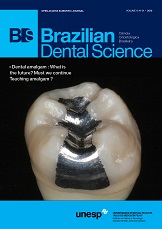Evaluation of different types of polishing of composite resin surfaces after the removal of metal and ceramic brackets
DOI:
https://doi.org/10.14295/bds.2015.v18i1.1085Abstract
Objective: To evaluate the effectivenessof different methods ofcomposite resin polishingafter the removaloforthodontic brackets. Material and Methods: 160resindiscsmade froma matrix ofacrylic resinwere divided into4 groups,according to thetype of composite resinused: G1 - microfilled(n = 40), G2 -microhybrid(n = 40), G3 -nanohybrid(n = 40)and G4-nanofilled(n = 40). One half of the samples wassubjectedto thermocycling, at 2000 cycles from 5 ? 2 ºC to 55 ? 2 ºC, for 1 min each. Halfof each group of resins was bonded with Gemini™ metallic brackets (3MUnitek) andthe otherhalf with Transcend™ ceramic brackets (3MUnitek). Thebrackets were transferred to auniversal testing machine (EMIC DLmodel2000).Half of the specimensfrom eachsubgroupwere polishedwith diamond burs andthe other halfwithSof-Lex discs. The averagesurface roughness of composite resin discswas measured,using aprofilometer,before the bondingof brackets, after the removal of brackets, after removing theexcess resinandafter polishing. Results: After removal of bracketsandafter polishing, the surface roughnesswas greater in the microhybridgroup(ANOVA, p < 0.05).After removalof ceramicbrackets, the groups showedhigher surfaceroughness (ANOVA, p < 0.05). There was no significantdifference inroughnessrelated tothermocyclingand the type ofpolishing.Conclusion:The qualityof thepolishis subjectedto the type ofresinused. Ceramicbrackets provided rougher surfacesafter removal. Both types ofpolishingusedare effective.
Downloads
Downloads
Published
How to Cite
Issue
Section
License
Brazilian Dental Science uses the Creative Commons (CC-BY 4.0) license, thus preserving the integrity of articles in an open access environment. The journal allows the author to retain publishing rights without restrictions.
=================




























